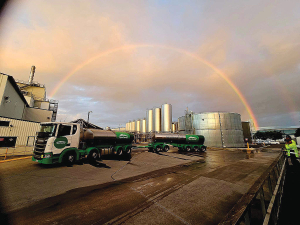Glut in global milk supply keeping prices down
The final Global Dairy Trade (GDT) auction has delivered bad news for dairy farmers.
 Open Country Dairy is telling its farmer suppliers that prices should increase further in the coming months. Photo credit: Open Country Dairy Facebook page. Callum Leslie.
Open Country Dairy is telling its farmer suppliers that prices should increase further in the coming months. Photo credit: Open Country Dairy Facebook page. Callum Leslie.
Following two consecutive Global Dairy Trade (GDT) price rises this year, overall prices now sit at their highest since June 2023.
Prices have lifted by around 25% since last year’s low in August. Overall prices are now up 3% on a year ago, 4% below their 5-year average levels and 5% above the 10-year average.
Westpac chief economist Kelly Eckhold believes that expectations of reduced production data in New Zealand and offshore may still be supporting prices.
Last week’s GDT auction saw the price index rise 2.3%, while key whole milk powder (WMP) prices lifted 1.7%.
Eckhold notes that the result was again broad based and followed on from a similarly strong initial auction for 2024 in the first week of January. All products posted price rises.
Butter and anhydrous milk fat prices led the way, surging 5.8% and 4.3% respectively.
“We didn’t have a formal forecast for the WMP price result this time but the general trend in dairy prices is in line with the upward adjustment we made to the season milk price just ahead of Christmas,” he says.
“The futures market had pointed to a small WMP price rise at this auction, and so this auction modestly surpassed those expectations.”
On the demand side, last week’s auction saw demand from China, Middle Eastern and Southeast Asian buyers. But Eckhold remains remain cautious on prospects for the Chinese economy and associated Chinese dairy demand.
He noted that deflation in consumer and producer prices continued in China according to data from late 2023.
“We are retaining our milk price forecast for this season at $7.50/kg, in line with the mid-point of Fonterra’s guidance,” he says.
Dairy prices have jumped in the overnight Global Dairy Trade (GDT) auction, breaking a five-month negative streak.
Alliance Group chief executive Willie Wiese is leaving the company after three years in the role.
A booklet produced in 2025 by the Rotoiti 15 trust, Department of Conservation and Scion – now part of the Bioeconomy Science Institute – aims to help people identify insect pests and diseases.
A Taranaki farmer and livestock agent who illegally swapped NAIT tags from cows infected with a bovine disease in an attempt to sell the cows has been fined $15,000.
Bill and Michelle Burgess had an eye-opening realisation when they produced the same with fewer cows.
It was love that first led Leah Prankerd to dairying. Decades later, it's her passion for the industry keeping her there, supporting, and inspiring farmers across the region.
President Donald Trump’s decision to impose tariffs on imports into the US is doing good things for global trade, according…
Seen a giant cheese roll rolling along Southland’s roads?